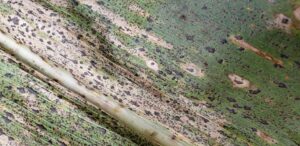
What is Tar Spot?
Tar Spot is a relatively new disease to Midwestern corn and is something all growers should be aware of as it can have serious yield impacts.
The pathogen was first identified in Mexico in 1904 and was considered a tropical disease of Latin America for over a century. It was first discovered in the United States in 2015 in Illinois and Indiana. After intense disease pressure in both 2018 and 2021, the pathogen can be found throughout Iowa, Illinois, Indiana, Wisconsin and Michigan along with parts of Ohio, Pennsylvania, Missouri, Nebraska, Minnesota, Florida and Georgia.
Tar Spot gets its name from the small, raised black spots on the corn leaves. Think similar to driving through a construction zone and getting a little bit of fresh asphalt on your car. These spots are on the upper and lower surfaces and can’t be scraped off. A tan or light brown lesion may surround the black ascomata creating a fisheye look. The Tar Spot pathogen loves moisture. Cool temps and extended periods of leaf wetness that occur late in the season are most conducive to disease progression. Roughly 60-70F and over seven hours of leaf wetness seem to be optimal. As the disease progresses, lesions cover more and more leaf tissue. This leads to a reduction in photosynthesis and a reduction in yield.
In heavy hit areas of Michigan, Indiana, and Illinois yield losses as high as 45% have been recorded. Thankfully a vast majority of farmers who have tar spot do not have pressure this high currently. Proactive management is key moving forward. This disease is relatively young in the US but current management tactics include:
- Use of fungicide products with multiple modes of action and timed accordingly. This means possibly spraying later in the year once conditions for disease progression appear. This may take the form of a second application after more traditional VT-R1 applications have lost efficacy.
- Residue management and crop rotation. The pathogen over winters in infected residue.
- Hybrid selection. The industry is beginning to take tar spot tolerance scores and we have some tentative ideas for some products.
- Management of overhead irrigation. There is data from 2021 that suggests managing overhead irrigation to reduce time of leaf wetness when possible can have positive yield impacts.
Follow the movement of Tar Spot through the country this season by using the by using the tracker from Corn impPIPE. You can also check out the Crop Protection Network for more info.
Photo Credit: UNL Cropwatch
